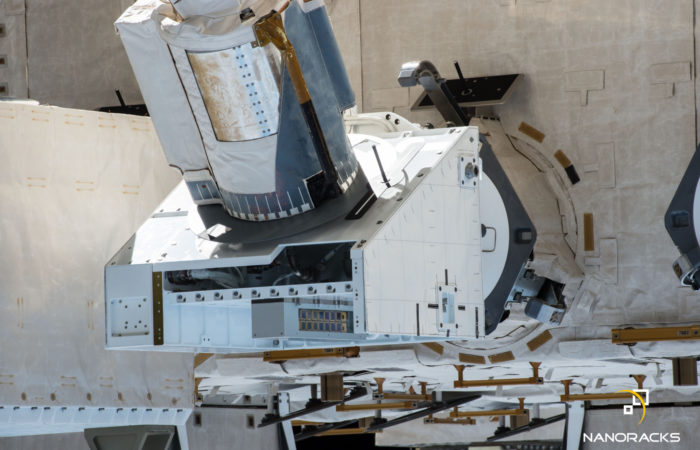Houston, Texas – May 1, 2017 – NanoRacks has successfully completed the change out of the second round of its privately owned External Platform (NREP) payloads mounted on the outside of the International Space Station (ISS). Thermo Fisher Scientific/Florida Institute of Technology’s Charge Injection Device (CID) and Honeywell Aerospace/Morehead State University’s Dependable Multiprocessing-7 (DM7) are both operational on the NREP platform and have begun to downlink data.
NREP, which is self-funded by NanoRacks, is externally mounted to the Station on the Japanese Experiment Module Exposed Facility and provides the first-ever commercial gateway to the extreme space environment. Following the CubeSat form factor, payloads can experience microgravity and radiation, observe earth, test sensors and electronics, and experience other harsh elements native to the space – all while having the ability to return the payload back to Earth. The External Platform is also a stepping-stone in NanoRacks’ growing programs towards building a deeper understanding of working in the outside environment of space, including developments in both the NanoRacks Airlock Module and the Ixion concept.
Both CID and DM7 were funded through a Center for the Advancement of Science in Space (CASIS) solicitation. CASIS is the manager of the ISS U.S. National Laboratory, with the mission to maximize use of this unparalleled microgravity research platform to benefit of life on Earth.
“One of the major roles for CASIS, as managers of the ISS National Laboratory, is to ensure that this laboratory in low earth orbit is continuously evolving to meet the needs of a diverse research community.” said CASIS Director of Operations and NASA Liaison Kenneth Shields. “Our commercial partners are a critical component in ensuring that National Laboratory customers like Honeywell Aerospace and the Florida Institute of Technology have access to the latest technologies and research tools. NanoRacks is one of the innovation leaders in our industry and we applaud their efforts and congratulate them on achieving yet another “first ever milestone” aboard the ISS National Laboratory.”
This payload swap out marks a significant milestone for NanoRacks as this is the first time the NREP has been brought in station and out of the ISS to both complete a mission cycle and by starting the next.
“Thank you to Astronauts Jack Fisher and Peggy Whitson for teaming together on the successful installation and swap-out of these NREP payloads,” says NanoRacks Operations Manager Keith Tran. “Dr. Peggy Whitson helped install the NREP on the JEM slide table the day she set the record for longest total number of day spent in space by an American astronaut. We’re very proud to have worked with her on commercial utilization of the ISS on this special day.”
About The Payloads:
Thermo Fisher Scientific/Florida Institute of Technology- Charge Injection Device (CID):
Charge Injection Device (CID) technologies have enabled intrinsic contrast ratios of one part in a billion to be achieved. These are the same kinds of contrast ratios between Earth-like planets and their host stars. CIDs may solve the “candle next to a lighthouse” problem and could be responsible for that first image of Earth 2.0. This technology also has many commercial applications, including those with environmental and defense interests. The next technology development step for CIDs is to demonstrate their functionality in low-Earth-orbit while exposed to the radiation environment of space.
Honeywell Aerospace/Morehead State University- DM7:
The designation of DM7 (Dependable Multiprocessing 7) is significant because the NREP-hosted ISS flight experiment provides DM CubeSat technology with the opportunity to achieve the critical TRL7 level of technology validation (the space environment). The benefits of flying COTS in space are the ability to fly 10x – 100x the processing capability of state-of-the-art radiation hardened processors for much lower cost and to allow space applications to keep pace with COTS development instead of being 2 or 3 generations behind terrestrial high performance processing.
To learn more about the services offered with the NanoRacks External Platform, email NanoRacks at info@nanoracks.com.
For continued updates, follow us on twitter @NanoRacks.

